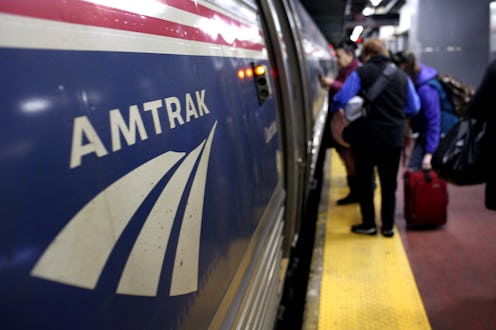News
What's A Train Black Box?
As the ongoing investigation into Tuesday night's derailment continues, officials have uncovered the Amtrak train's black box on Wednesday morning. Also known as the event recorder, the box has been sent to the Amtrak Operations Center in Delaware to be analyzed. Before that data is made public, what we know so far is that all seven train cars derailed at around 9:30 p.m., killing six people so far and injuring more than 200. What we don't know yet is what exactly caused the derailment and any other factors that may have contributed to it, but soon the data recorded on the black box will hopefully be able to answer those questions. (Update: Eight passengers have now been confirmed dead.)
Philadelphia Mayor Michael Nutter announced at a news conference on Wednesday that investigators with the National Transportation Safety Board (NTSB) have found the train's black box and sent it to Amtrak's operations center for analysis. In this preliminary stage of the investigation, officials are focusing on speed as the possible culprit of the crash, which the black box could help confirm or reveal other circumstances that led to the derailment.
Deborah Hersman, former chair of the NTSB, told ABC News that black boxes are vital for these kinds of investigations:
The black boxes will tell them things like speed, throttle position, braking.... But also there are often inward and outward facing video cameras that will tell them a lot of information about the track conditions and the environmental conditions. The key to the team is going to be grabbing those recorders right away.
You may have heard of these black boxes in relation to the recent high-profile airplane crashes, but the concept of a train black box might be a new one. Well, they're virtually the same exact thing, and record the same types of data for identical purposes.
What It Looks For
Just like a flight data recorder records the circumstances that affect flight performance, a train event recorder records all the factors that could affect a train journey. According to official U.S. regulations, these black boxes record the following:
- Train speed
- Direction of motion
- Time
- Distance
- Throttle position
- Brake applications and operations (including train brake, independent brake, and, if so equipped, dynamic brake applications and operations)
- Cab signal aspect(s)
While this is the general data that black boxes record, there is a specific list of "safety-critical" signals that are particularly pertinent to post-accident investigations. They are:
- Speed
- Direction of travel (forward or reverse)
- Time
- Distance
- Throttle position
- Operation of brakes
- Status of headlights and marker lights (on or off)
- Operation of horn
- Status of cab signals
Special Features
These event recorders are designed to resist tampering and are able to withstand heat of up to 750 degrees Celsius for one hour (in case the train catches on fire), impact shock of up to 55 g-force, static crush of 110 kN for five minutes (in case the train collides into another blunt object), liquid immersion (including fresh water, salt water, diesel, and lube oil) for two days, and hydrostatic pressure equivalent to being submerged 15 miles in water for two days.
The box will also store the most recent 48 hours of safety-critical data so it won't be overridden in case the box continues to record in the post-accident investigation process.
What They're Used For
Like flight recorders, train black boxes are used to determine the causes of incidents and accidents by analyzing their recorded data (listed above). In addition to providing crucial information for investigations, these recorders are also used to monitor traction unit performance, the behavior and capability of conductors, and the general conditions of train over time.
Images: Getty Images (4)
